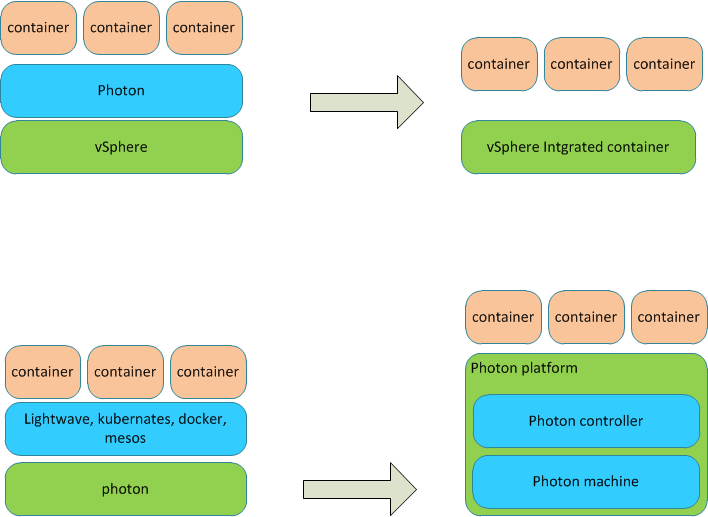Author
In the previous articles (Part 1 and Part 2) we’ve talked about Photon and Docker are a new way to developed and put new generation applications into production. Indeed, containers and “microservice” development techniques are the architectural and cultural elements that determine a significant shift in the way of managing cloud-native applications within their life cycle. As cloud-native applications is a very hot topic in the IT world, it’s easy to find on the Web new announces and information that can make obsolete some elements covered in the previous articles.
As a matter of fact, the announcement of the devbox based on Photon Controller and the implementation of new clustering mechanisms in containers are now available to the community world by means of the technology preview channel of VMware.

Articles of the VPS column:
- VPS: the cores trick
- VPS (second part): the SSD trick
- VPS (third part): evaluating performances
- VPS (fourth part): basic troubleshooting in Linux
Linux is a system equipped with countless diagnostic tools that can be used with a command line interface (CLI) allowing sysadmins to identify and solve problems and malfunctionings. Regardless of the typical limitations of a textual environments, these supporting programs are really powerful as they can be invoked by simple commands or placed into automated scripts. In this article we’ll cover some of the most common: top, ps and netstat.
top and htop: processes, workload and memory under control
top is the command used to identify processes, a clear indicator of the system health state and allows to check parameters such as CPU and memory usage percentage in addition to the actual state of active processes.
Read more VPS (fourth part): basic troubleshooting in LinuxThe evolution of applications development methods towards the Cloud are the real driving force that leads the creation of new generation services that are encapsulated into software structures called containers.
As we saw in the last article, Photon, Docker and containers represent the architectural objects that were born from a revolution in the way of developing cloud-native applications.
After analyzing shortly the matter from a systems perspective, it’s now the time to focus from a “DevOps” point of view, that is, starting with the creation of container images and concluding with their execution.
Developing in the “Datacenter-in-a-box” Read more Cloud Native Apps: the VMware platform (second part)
The evolution towards cloud solutions is one of the biggest revolutions in the IT sphere and it is completely changing the way of planning and evaluating infrastructures in a business setting.
It’s not a piece of news that the Infrastructure as a Service (Iaas) architectures allow system administrators to leverage the service model to consolidate servers, increase the availability of business applications and, in most cases, even to lower costs.
In the transition from virtualization to cloud, VMware has been one of the reference players for sure thanks to its advantage gained in those years when it really was the only company that invested in the development of virtual solutions. Nowadays -whatever the vendor of my hypervisor might be- virtual machines, as a matter of fact, are the fundamental computing unit of an IT system.
However, something is deeply changing in IaaS architectures: we’re talking about two important innovations such as the development of applications built natively for a cloud architecture and containers, which radically simplify the implementation and the development of the more traditional applications. VMware is naturally working as quick as possible to maintain its advantage in this sector too.
Let’s see how by analyzing the solutions introduced during the last VMworld (Europe and USA).
Anatomy of a cloud-native application
According to Kit Colbert -VMware’s VP & CTO and Team Leader of the Cloud Native Application project- the term cloud-native is used for these last-generation applications built on top of dynamic and elastic infrastructures. Software defined datacenter, coupled with the infrastructural elements of the vSphere and NSX packages, is the ideal setting where to run traditional and cloud-native applications.
-
BYOD: your devices for your firm
The quick evolution of informatics and technologies, together with the crisis that mined financial mines, has brought to a tendency inversion: users that prefer to work with their own devices as they’re often more advanced and modern than those the companies would provide. Read More -
A switch for datacenters: Quanta LB4M
You don’t always have to invest thousands of euros to build an enterprise-level networking: here’s our test of the Quanta LB4M switch Read More -
Mobile World Congress in Barcelona
GURU advisor will be at the Mobile World Congress in Barcelona from February 22nd to 25th 2016!
MWC is one of the biggest conventions about the worldwide mobile market, we'll be present for the whole event and we'll keep you posted with news and previews from the congress.
Read More
- 1

























